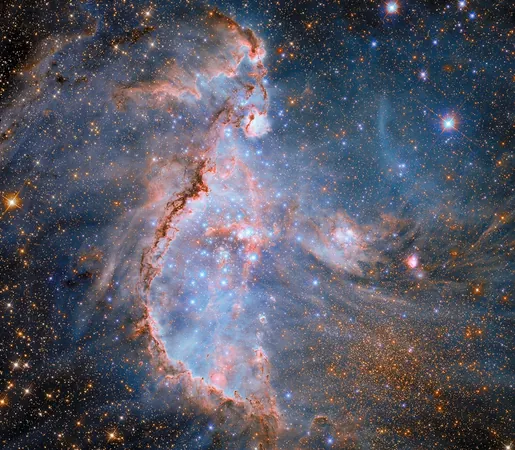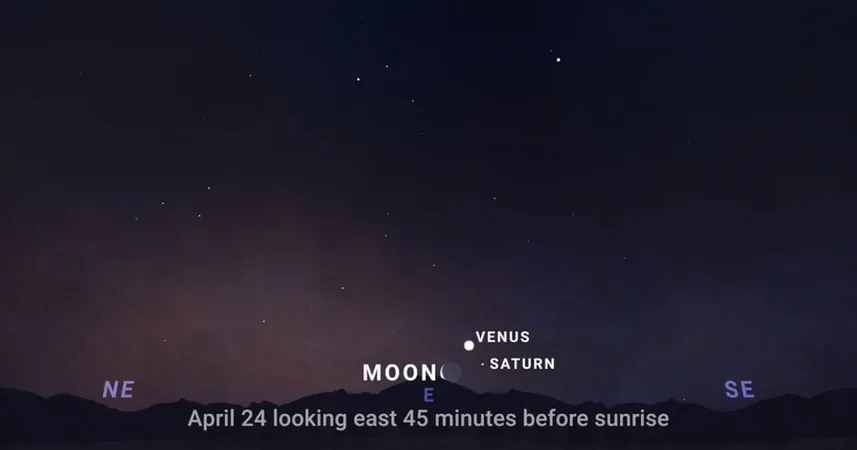
Hubble Reveals Stunning Stellar Sculptors in a Nearby Galaxy
2025-04-14
Author: Jacques
Unlocking the Secrets of NGC 346
On April 4, 2025, a mesmerizing new image from the Hubble Space Telescope was unveiled, showcasing the vibrant young star cluster known as NGC 346. While both the Hubble and the James Webb Space Telescope have previously presented images of this stellar wonder, this latest version is groundbreaking. It uniquely amalgamates observations across infrared, optical, and ultraviolet wavelengths, offering an exquisitely detailed glimpse into this active star-forming region.
A Stellar Playground 200,000 Light-Years Away
Nestled within the Small Magellanic Cloud—a satellite galaxy of our own Milky Way—NGC 346 lies a staggering 200,000 light-years away in the constellation Tucana. Unlike our galaxy, the Small Magellanic Cloud has a lower abundance of heavier elements, often referred to by astronomers as 'metals.' This distinct composition creates an environment akin to the conditions of the early universe, making NGC 346 a celestial treasure trove for scientists.
Birthplace of Over 2,500 New Stars
Home to an astonishing array of over 2,500 newborn stars, NGC 346 showcases the dynamic beauty of stellar birth. The cluster’s most massive stars shine in a brilliant blue, illuminating the surrounding nebula in hues of glowing pink, while dark, snakelike clouds weave through the scene, shaped by the ferocious energy of these luminous stars.
Hubble's Key Role in Unveiling Star Formation
Hubble's incredible sensitivity and resolution have been pivotal in peeling back the layers of NGC 346's star formation processes. Researchers, utilizing observations from two separate years—11 years apart—discovered that the stars in this cluster are spiraling inward toward its core. This gravitational dance is fueled by a stream of gas from outside the cluster, feeding the star formation at the heart of this turbulent cosmic cloud.
The Sculptors of the Nebula
In essence, the stars in NGC 346 act as cosmic sculptors, carving out vacancies within the surrounding nebula. The intense radiation and fierce stellar winds generated by these hot, massive stars bombard the gas from which they were born, effectively reshaping their celestial environment.
Why This Discovery Matters
This groundbreaking imagery not only enriches our understanding of star formation but also serves as a magnificent reminder of the universe's dynamic and ever-changing beauty. As astronomers continue to study such phenomena, each discovery brings us one step closer to unraveling the mysteries of the cosmos.









 Brasil (PT)
Brasil (PT)
 Canada (EN)
Canada (EN)
 Chile (ES)
Chile (ES)
 Česko (CS)
Česko (CS)
 대한민국 (KO)
대한민국 (KO)
 España (ES)
España (ES)
 France (FR)
France (FR)
 Hong Kong (EN)
Hong Kong (EN)
 Italia (IT)
Italia (IT)
 日本 (JA)
日本 (JA)
 Magyarország (HU)
Magyarország (HU)
 Norge (NO)
Norge (NO)
 Polska (PL)
Polska (PL)
 Schweiz (DE)
Schweiz (DE)
 Singapore (EN)
Singapore (EN)
 Sverige (SV)
Sverige (SV)
 Suomi (FI)
Suomi (FI)
 Türkiye (TR)
Türkiye (TR)
 الإمارات العربية المتحدة (AR)
الإمارات العربية المتحدة (AR)